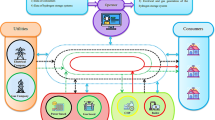Abstract
Economic dispatch and demand side management are two of the most important tools for efficient energy management in the grid. It is a casual observation that both these processes are intertwined and thus complement each other. Strategies aiming to optimize economic dispatch have implications for demand side management techniques and vice versa. In this paper, we present a genetic algorithm-based solution which combines economic dispatch and demand side management for residential loads in a micro-grid. Our system collects preferences of demand data from consumers and costs of energy of various sources. It then finds the optimal demand scheduling and energy generation mix for the given time window. Our evaluations show that the given approach can effectively reduce operating costs in a single- and multiple-facility micro-grids for both suppliers and consumers alike.



Similar content being viewed by others
References
Albadi, M.H., & El-Saadany, E.F. (2007). Demand response in electricity markets: An overview. In Power engineering society general meeting, 2007 (pp. 1–5). IEEE
Amjady, N. (2007) Short-term bus load forecasting of power systems by a new hybrid method. IEEE Transactions on Power Systems, 22(1), 333–341.
Behrangrad, M., Sugihara, H., Funaki, T. (2011). Effect of optimal spinning reserve requirement on system pollution emission considering reserve supplying demand response in the electricity market. Applied Energy, 88(7), 2548–2558.
Borenstein, S. (2005). The long-run efficiency of real-time electricity pricing. The Energy Journal, 26(3), 93–116.
Coll-Mayor, D., Paget, M., Lightner, E. (2007). Future intelligent power grids: analysis of the vision in the European Union and the United States. Energy Policy, 35(4), 2453–2465.
Conejo, A.J., Morales, J.M., Baringo, L. (2010). Real-time demand response model. IEEE Transactions on Smart Grid, 1(3), 236–242.
Dimeas, A.L., & Hatziargyriou, N.D. (2005). Operation of a multiagent system for microgrid control. IEEE Transactions on Power Systems, 20(3), 1447–1455.
Farhangi, H. (2010). The path of the smart grid. IEEE Power and Energy Magazine, 8(1), 18–28.
Gellings, C.W., & Chamberlin, J.H. (1993). Demand-side management: Concepts and methods (1st edn.). Lilburn: Fairmont.
Gomez-Villalva, E., & Ramos, A. (2003). Optimal energy management of an industrial consumer in liberalized markets. IEEE Transactions on Power Systems, 18(2), 716–723.
Gudi, N., Wang, L., Devabhaktuni, V., Depuru, S.S.S.R. (2011). A demand-side management simulation platform incorporating optimal management of distributed renewable resources. In Power systems conference and exposition (PSCE), 2011 (pp. 1–7). IEEE/PES
Holland, S.P., & Mansur, E.T. (2006). The short-run effects of time-varying prices in competitive electricity markets. The Energy Journal, 27(4), 127–156.
Ipakchi, A., & Albuyeh, F. (2009). Grid of the future. IEEE Power and Energy Magazine, 7(2), 52–62.
Jiayi, H., Chuanwen, J., Rong, X. (2008). A review on distributed energy resources and microgrid. Renewable and Sustainable Energy Reviews, 12(9), 2472–2483.
Lasseter, R., Akhil, A., Marnay, C., Stephens, J., Dagle, J., Guttromson, R., Sakis Meliopoulous, A., Yinger, R., Eto, J. (2002). Integration of distributed energy resources: the certs microgrid concept. Berkeley, California: Lawrance Buckley National Lab.
Lasseter, R.H., & Paigi, P. (2004). Microgrid: A conceptual solution. In 2004 IEEE 35th annual power electronics specialists conference, 2004. PESC 04. (Vol. 6, pp. 4285–4290).
Livengood, D., & Larson, R.C. (2009). Energy box: locally automated optimal control of residential electricity usage. Service Science, 1(1), 1–16.
Michalewicz, Z. (1995). Genetic algorithmsnumerical optimizationand constraints. In Proceedings of the 6th international conference on genetic algorithms (pp. 151–158). San Francisco, CA: Morgan Kaufmann Publishers Inc.
Parvania, M., & Fotuhi-Firuzabad, M. (2010). Demand response scheduling by stochastic scuc. IEEE Transactions on Smart Grid, 1(1), 89–98.
Philpott, A.B., & Pettersen, E. (2006). Optimizing demand-side bids in day-ahead electricity markets. IEEE Transactions on Power Systems, 21(2), 488–498.
Ranade, V.V., & Beal, J. (2010). Distributed control for small customer energy demand management. In 4th IEEE international conference on self-adaptive and self-organizing systems (SASO), 2010, 27 Sept–1 Oct 2010 (pp. 11–20).
Shahidehpour, M., Yamin, H., Li, Z. (2002). Market operations in electric power systems: Forecasting, scheduling, and risk management (1st edn.). New York: Wiley–IEEE Press.
Shivakumar, A., Abeysekera, M., Silva, C.A., Pina, A. (2013). Unit commitment model with demand response and wind energy integration. In ICAE ’2013: Proceedings of the fifth international conference on applied energy.
Tsikalakis, A.G., & Hatziargyriou, N.D. (2008). Centralized control for optimizing microgrids operation. IEEE Transactions on Energy Conversion, 23(1), 241–248.
Vittal, V. (2010). The impact of renewable resources on the performance and reliability of the electricity grid. In Bridge (Vol. 40). Washington DC: National Academy of Engineering of the National Academies.
Weron, R. (2006). Modeling and forecasting electricity loads and prices: a statistical approach (the Wiley finance series). England: Wiley.
Yalcinoz, T., Altun, H., & Uzam, M. (2001). Economic dispatch solution using a genetic algorithm based on arithmetic crossover. In Power tech proceedings, 2001 IEEE Porto (Vol. 2, p. 4).
Zareipour, H., Bhattacharya, K., Canizares, C. (2004). Distributed generation: current status and challenges. In 36th annual north americal power symp. (NAPS), Moscow, ID.
Acknowledgements
We wish to thank our donors the National ICT R&D Fund of Pakistan, Higher Education Commission of Pakistan, and Department of Computer Science at LUMS for partially funding this work.
Author information
Authors and Affiliations
Corresponding author
Rights and permissions
About this article
Cite this article
Arif, A., Javed, F. & Arshad, N. Integrating renewables economic dispatch with demand side management in micro-grids: a genetic algorithm-based approach. Energy Efficiency 7, 271–284 (2014). https://doi.org/10.1007/s12053-013-9223-9
Received:
Accepted:
Published:
Issue Date:
DOI: https://doi.org/10.1007/s12053-013-9223-9




